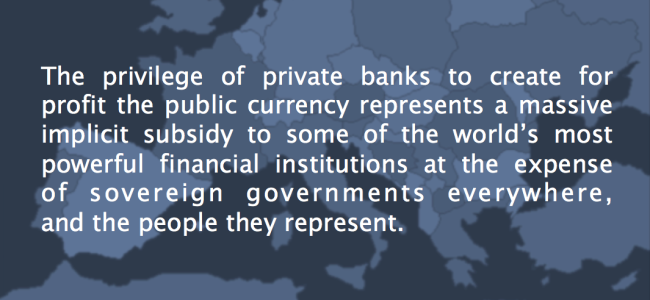In the UK, the Labour Party candidate Jeremy Corbyn has triggered a lot of attention on the problems with the Bank of England’s QE and how we could use it in a better way.

Labour leadership candidate Jeremy Corbyn has sparked a major debate about monetary and economic policy by calling for what he calls a ‘People’s QE’.
He argues that ‘The Bank of England must be given a new mandate to upgrade our economy to invest in new large scale housing, energy, transport’. People’s QE is similar to proposals called for by Positive Money. We call the idea ‘Sovereign Money’. Ideas in a similar vein have been advocated or at least suggested by notable economists including J M Keynes (1), Milton Friedman (2), Ben Bernanke (3), William Buiter (4) and Martin Wolf (5). Most recently, Lord Adair Turner (6) has proposed similar ideas, highlighting that ‘there are no technical reasons to reject this option’.
Like Quantitative Easing (QE), Sovereign Money relies on the Bank of England creating money and putting this money into the economy. But whereas QE relied on flooding financial markets and hoping that some of this money would ‘trickle down’ to the real economy, Sovereign Money works by injecting new money directly into the real economy, via government spending, tax cuts or rebates.
Sovereign Money (or People’s QE) tackles the current government’s flawed growth strategy, which is to grow the economy through ever rising household debt. As former FSA chairman Lord Turner put it, this is a “hair of the dog” strategy (7) for economic recovery, treating the cause of the financial crisis – excessive borrowing – as though it could also be the solution. The Office for Budget Responsibility predicts household debt to income ratio surpassing pre crisis levels by 2019 (8).
The pivotal advantage of Sovereign Money is that it requires no increase in either household debt or Government debt. In fact, Sovereign Money can actually reduce the overall levels of household debt. This deleveraging would also make banks more liquid and the economy fundamentally safer.
A common concern with Sovereign Money is that cooperation between the fiscal and monetary authorities is seen as a ‘taboo’ and that it would undermine the Bank of England’s independence. However this argument fails to acknowledge that fiscal and monetary cooperation has already been carried out by recent policies including: Funding for Lending, Help to Buy, and Quantitative Easing. The difference with Sovereign Money is that the monetary and fiscal cooperation will have to be more explicit.
Another strong concern is that it will lead to the power to create money being excessively used, resulting in high levels of inflation. A strong governance structure is vital, whilst there are several ways to structure the process, Positive Money advocates the Monetary Policy Committee (who decide how much money to create), is separated from the decision of how to spend the money (the government). The simplest way to ensure that the central bank does not create too much money is for monetary policy to continue targeting inflation (on its own or as part of a broader set of targets).
In addition, there is no reason why it should be more inflationary than the creation of money by bank lending (which typically creates inflation in the housing market). Whereas most money created via bank lending goes into the property market, the money created via Sovereign Money creation would go directly into the veins of the real economy, boosting GDP and employment. By boosting the capacity of the economy, Sovereign Money should actually be less inflationary than further consumer lending, and the use of Sovereign Money can be restricted should it start to become inflationary.
——-
1) Keynes, J. M. (1933). An Open Letter to President Roosevelt. New York Times
2) Friedman, M. (1948). A monetary and fiscal framework for economic stability. The American Economic Review, 38(3), 245-264
3) Bernanke, B. S. (2003). Some thoughts on monetary policy in Japan. Speech before the Japan Society of Monetary Economics, 31 May, Tokyo, Japan
4) Buiter, W. H. (2003). Helicopter money: irredeemable fiat money and the liquidity trap (No. w10163). National Bureau of Economic Research
5) Wolf, M. (2013). The case for helicopter money. Financial Times. 12th February 2013
6) http://www.ft.com/cms/s/0/8e3ec518-68cf-11e4-9eeb-00144feabdc0.html#ixzz3IjZNT6bq

